NCERT Class 11 Biology Chapter 2 Biological Classification Notes
NCERT Class 11 Biology Chapter 2 Notes
NCERT Class 11 Biology Chapter 2 Biological Classification Notes-Topic 1:
Introduction: A Two Kingdom system of classification was developed during Linnaeus' time, with Plantae and Animalia kingdoms encompassing all plants and animals, respectively. This system grouped together eukaryotes and prokaryotes, unicellular and multicellular creatures, photosynthetic (green algae) and non-photosynthetic (fungi) species. Although classifying organisms into plants and animals was simple and straightforward, There were a lot of species that didn't fit into either group. As a result, the two-kingdom classification, which had been in use for a long time, was determined to be inadequate.
Five Kingdom Classification:
A Five Kingdom Classification was proposed by R.H. Whittaker in 1969. Monera, Protista, Fungi, Plantae, and Animalia were the kingdoms he defined. Cell structure, body organization, manner of nourishment, reproduction, and phylogenetic links are among his key classification criteria. The table compares and contrasts the five kingdoms' various qualities.
Characters | Kingdoms | ||||
Monera | Protista | Fungi | Plantae | Animalia | |
Cell type | Prokaryotic | Eukaryotic | Eukaryotic | Eukaryotic | Eukaryotic |
Cell Wall and its component | Present, Peptidoglycan | Absent | Present, chitin | Present, cellulose | Absent |
Nuclear membrane | Absent | Present | Present | Present | Present |
Level of Organisation of the body | Unicellular | Unicellular | multicellular / loose tissue | Multicellular body differentiated into tissue / organ | Multicellular body is differentiated into a tissue / organ / organ system. |
Mode of nutrition | Autotrophic and heterotrophic | Autotrophic and heterotrophic | Heterotro-phic (Saprophy-tic or Parasitic) | Autotrophic (Exception: Cascuta shows parasitic nutrition) | Heterotro-phic |
NCERT Class 11 Biology Chapter 2 Biological Classification Notes-Topic 2:
Kingdom Monera :
The Monera Kingdom is entirely made up of bacteria. They are the most common microorganisms on the planet. Bacteria can be found practically anywhere. Hundreds of bacteria can be found in a single handful of soil. They also exist in harsh environments like hot springs, deserts, snow, and deep oceans, where only a few other species can survive. As parasites, many of them live in or on other species.
The spherical Coccus (pl.: cocci), the rod-shaped Bacillus (pl.: bacilli), the comma-shaped Vibrium (pl.: vibrio), and the spiral Spirillum (pl.: spirilla) are the four types of bacteria classified by their shape.
Although bacteria have a simple structure, their behaviour is extremely sophisticated. Bacteria, in comparison to many other creatures, have the greatest metabolic diversity. Some bacteria are autotrophic, meaning they make their nourishment from inorganic sources.
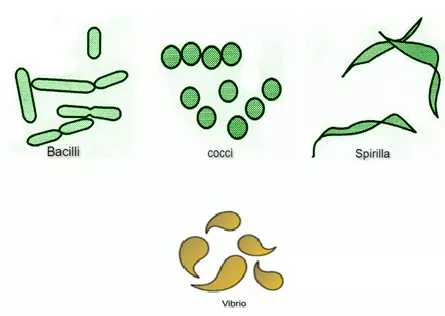
Different shapes of bacteria
NCERT Class 11 Biology Chapter 2 Biological Classification Notes-Sub Topic 2.1:
Archaebacteria: These bacteria are unique in that they survive in extremely salty environments (halophiles), hot springs (thermoacidophiles), and marshy environments (methanogens).
Archaebacteria vary from other bacteria in that they have a unique cell wall construction that allows them to survive in harsh environments.
Methanogens are bacteria that live in the guts of ruminant animals like cows and buffaloes and are responsible for the creation of methane (biogas) from their faeces.
NCERT Class 11 Biology Chapter 2 Biological Classification Notes-Sub Topic 2.2:
Eubacteria: “True bacteria” is a term used to describe these organisms. They have a peptidoglycan cell wall. They come in both autotrophic and heterotrophic forms. Autotrophs are photosynthetic or chemosynthetic. Chlorobium (bacteria that produce green sulphur) and Sulphur, chromium, or chemosynthetic bacteria.
NCERT Class 11 Biology Chapter 2 Biological Classification Notes-Topic 3:
Kingdom Protista :
Protista includes all single-celled eukaryotes, but the kingdom's boundaries aren't well defined. To one biologist, a photosynthetic protist is a plant, while to another, it is a plant. Chrysophytes, Dinoflagellates, Euglenoids, Slime Moulds, and Protozoans are all classified as Protista in this book. Protista is primarily an aquatic phylum.
This kingdom is linked to the kingdoms of plants, animals, and fungi.
NCERT Class 11 Biology Chapter 2 Biological Classification Notes-Sub Topic 3.1:
Chrysophytes: Diatoms and golden algae are members of this group (desmids). They can be found both in freshwater and in the ocean. They are microscopic and float passively in water currents (plankton). They are mostly photosynthetic. The cell walls of diatoms form two thin overlapping shells.
NCERT Notes for Standard 11 Biology Chapter 2-Sub Topic 3.2:
Dinoflagellates: They are photosynthesis microorganisms that live in the sea. They assist marine plants in photosynthesis. Gonyaulax, a red dinoflagellate, is one type of dinoflagellate that reproduces rapidly and forms red tides.
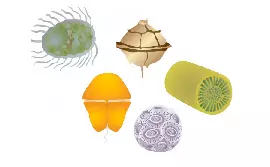
Dinoflagellates
Euglenoids: The majority are freshwater creatures that live in stagnant water. They contain a protein-rich layer called a pellicle instead of a cell wall, which allows them to bend their bodies.
They have two flagella, one that is short and the other that is long. When they are exposed to sunlight, they are photosynthetic, but when they are not, they behave like heterotrophs, predating on other smaller species. Euglenoids have pigments that are nearly identical to those found in higher plants.
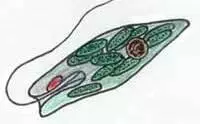
Euglenoid
Slime Moulds: Slime moulds are protists that feed on their surroundings. The organism eats organic matter as it glides along rotting twigs and leaves. They develop a plasmodium aggregation under the right conditions, which can grow and spread over many feet. The plasmodium develops and generates fruiting bodies with spores at their tips in unfavorable conditions. True walls exist within the spores. They are highly hardy and may live for many years in harsh environments.

Slime Mould
Protozoans: Protozoans are all heterotrophic, meaning they exist as predators or parasites. Animal relatives are thought to be their ancestors. Protozoans are divided into four categories.
Amoeboid protozoans: Freshwater, seawater, and moist soil are all suitable habitats for these organisms. They move and capture their prey in the same way that Amoeba does. The surface of marine animals is covered with silica shells. Entamoeba, for example, is a parasitic worm.
Flagellated protozoans: This group's members are either free-living or parasitic. They have flagella on their bodies. Trypanosoma is a good example.
Ciliated Protozoans: Due to the presence of thousands of cilia, these organisms are aquatic and actively moving. On the cell surface, they feature a cavity (gullet) that opens to the outside. Paramoecium is a good example shown in the figure below.
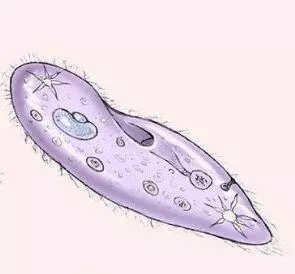
Paramoecium
Sporozoans: This comprises a wide range of species with a spore-like stage in their life cycle. Plasmodium (malarial parasite), which causes malaria, is the most well-known.
NCERT Class 11 Biology Chapter 2 Biological Classification Notes-Topic 4:
Kingdom Fungi :
Fungi are a distinct kingdom of heterotrophic creatures. They have a wide range of forms and environments. Fungi are seen on moist bread and rotten fruits. The common mushroom for eating and toadstools are also fungi. Fungi's cell walls are made up of chitin and carbohydrates. Saprophytes are fungi that are heterotrophic and absorb soluble organic materials from dead substrates. Parasites are organisms that rely on live plants and animals for their survival. They can also exist as symbionts, forming lichens with algae and mycorrhizae with higher plant roots.
Fungi reproduce asexually through vegetative mechanisms like as fragmentation, fission, buddy, or the formation of conidia/sporangia spores/ zoospores. Oospores, ascospores, and basidiospores are used in sexual reproduction.
NCERT Notes for Standard 11 Biology Chapter 2-Sub Topic 4.1:
Classification of Fungi:
On the basis of the mycelium mode of spore generation and fruiting bodies, fungi are categorized into distinct classes.
Phycomycetes: Phycomycetes can be found in aquatic habitats, on decaying wood in moist and damp environments, and as obligate parasites on plants. The mycelium is coenocytic and aseptate. Asexual reproduction occurs via zoospores (motile) or aplanospores (asexual) (non-motile). Mucor is a common example. They produce sex organs i.e., microspores and megaspores inside respective sporangium but do not have any distinct fruit bodies.
Ascomycetes: The ascomycetes, also known as sac-fungi, are mostly multicellular (e.g., Penicillium) or rarely unicellular (e.g., Saccharomyces). Saprophytic, decomposers, parasitic, or coprophilous (growing on dung), they are all types of organisms. The spores are called ascospores and are produced endogenously in asci (singular ascus)
Basidiomycetes: Mushrooms, bracket fungi, and puffballs are examples of basidiomycetes. Rust fungi and smut fungi, for example, are parasites in living plant bodies. The mycelium is septate and branched. They produce basidiospores within specific fruit bodies basidium.
Deuteromycetes: They are commonly referred to as imperfect fungi because only the vegetative or asexual phases of these fungi are known. They were placed in the appropriate classes when the sexual forms of these fungi were discovered. Mycelium is branched and septate. Alternaria, Colletotrichum, and Trichoderma are some examples.
NCERT Class 11 Biology Chapter 2 Biological Classification Notes-Topic 5:
Kingdom Plantae :
Plantae refers to all eukaryotic chlorophyll-containing organisms that are commonly referred to as plants. A few members, such as insectivorous plants and parasites, are partially heterotrophic. Insectivorous plants such as bladderwort and Venus fly trap exist, and Cuscuta is a parasite. Plant cells are eukaryotic in nature, with prominent chloroplasts and a cellulose-based cell wall.
Plants have two distinct phases in their life cycle: diploid sporophytic and haploid gametophytic, which alternate.
NCERT notes for Class 11 Biology chapter 2 does not provide enough details, you will study about kingdom plantae in detail in further chapters.
NCERT Class 11 Biology Chapter 2 Biological Classification Notes-Topic 6:
Kingdom Animalia :
This kingdom is made up of heterotrophic eukaryotic organisms that are multicellular and lack cell walls. They rely on plants for food, either directly or indirectly. Food is digested in an internal cavity, and food reserves are stored as glycogen or fat. Their mode of nutrition is holozoic, which means they eat. They have a definitive growth pattern and mature into adults with distinct shapes and sizes. They reproduce through sexual means.
NCERT notes for Class 11 Biology chapter 2 does not provide enough details, you will study kingdom Animalia in detail in further chapters.
NCERT Class 11 Biology Chapter 2 Biological Classification Notes-Topic 7:
Viruses, Viroids, Prions and Lichens:
NCERT Notes for Standard 11 Biology Chapter 2-Sub Topic 7.1:
Viruses: Viruses are non-cellular organisms with an inert crystalline structure that exists outside of the living cell. Outside the living cell, they form a thin loose covering, but they can multiply inside the host cell. They replicate themselves by taking over the host's body.
They have viral genetic material called DNA or RNA, which allows them to grow and multiply inside the host cell. It causes diseases in humans such as AIDS, mumps, smallpox, herpes, and influenza. It causes leaf curling and rolling in plants, as well as yellowing and clearing dwarfing and stunted growth.

Different shapes and sizes of viruses
NCERT Notes for Standard 11 Biology Chapter 2-Sub Topic 7.2:
Viroids: T.O. Diener discovered a new infectious agent that caused potato spindle tuber disease in 1971. It was smaller than viruses. It was discovered to be a free RNA that lacked the protein coat that viruses have, thus the name viroid. The viroid's RNA had low molecular weight.
NCERT Notes for Standard 11 Biology Chapter 2-Sub Topic 7.3:
Prions: Certain infectious neurological diseases have been discovered to be transmitted by an agent made up of abnormally folded protein in modern medicine. The agent was about the same size as viruses. Prions were the name given to these agents. The most well-known prion diseases are bovine spongiform encephalopathy (BSE), also known as mad cow disease in cattle, and its human counterpart Cr–Jacob disease (CJD).
NCERT Notes for Standard 11 Biology Chapter 2-Sub Topic 7.4:
Lichens: Lichens are symbiotic, or mutually beneficial, relationships between algae and fungi. The algae component is referred to as phycobiont, whereas the fungal component is referred to as mycobiont. Autotrophic and heterotrophic organisms, respectively. For algae, fungi provide accommodation as well as mineral nutrients and water. whereas algae provide food for fungi.
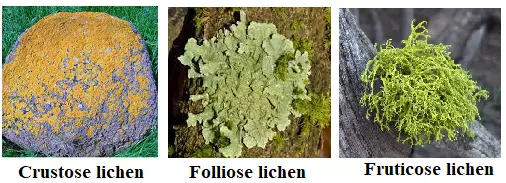
Comments
Post a Comment